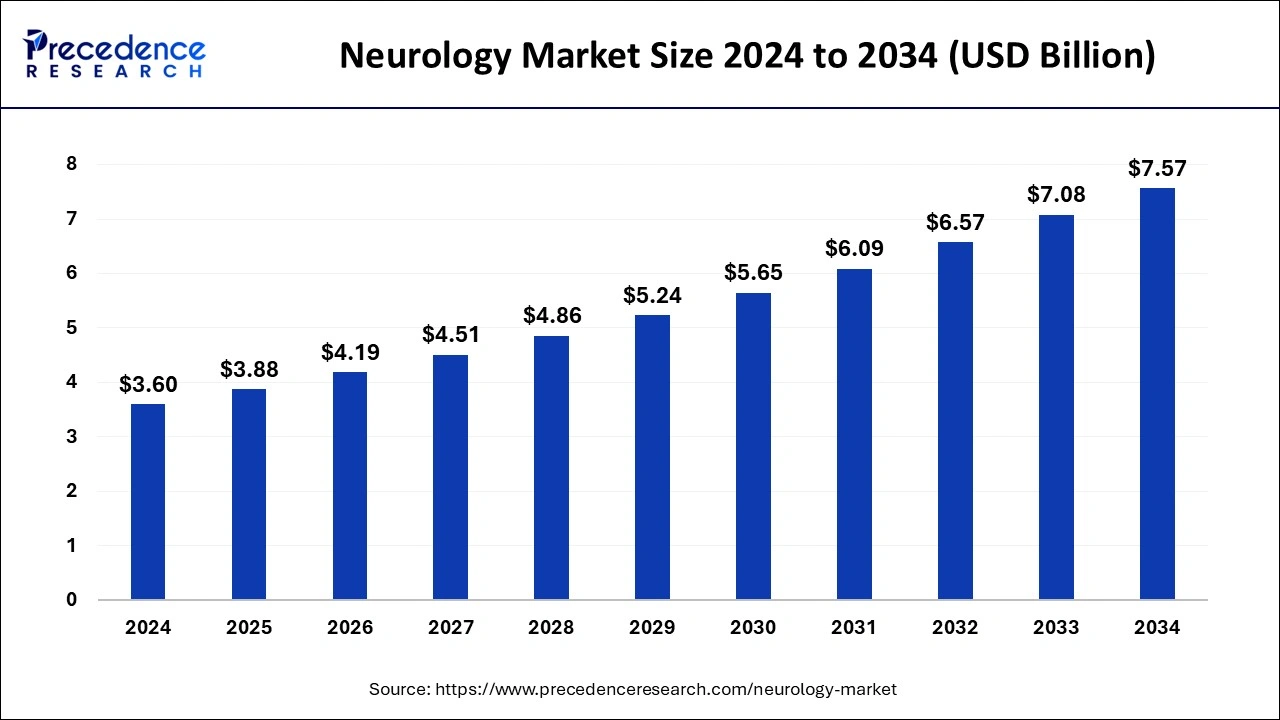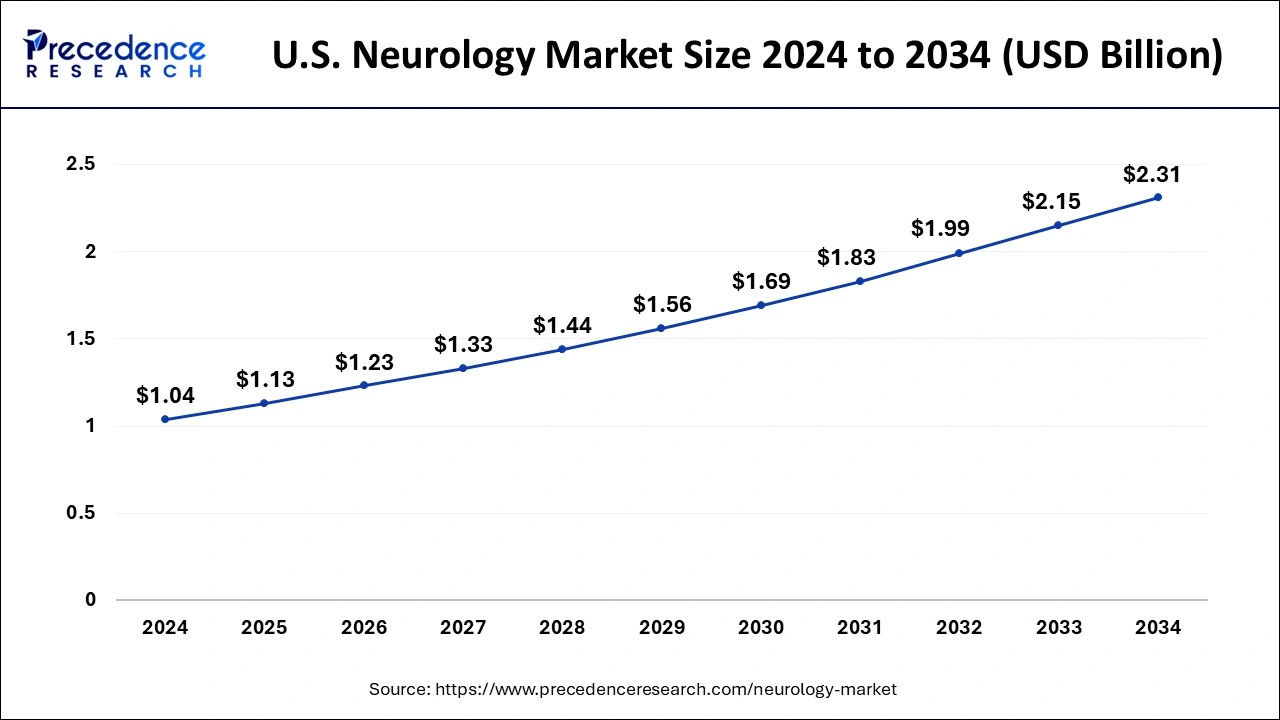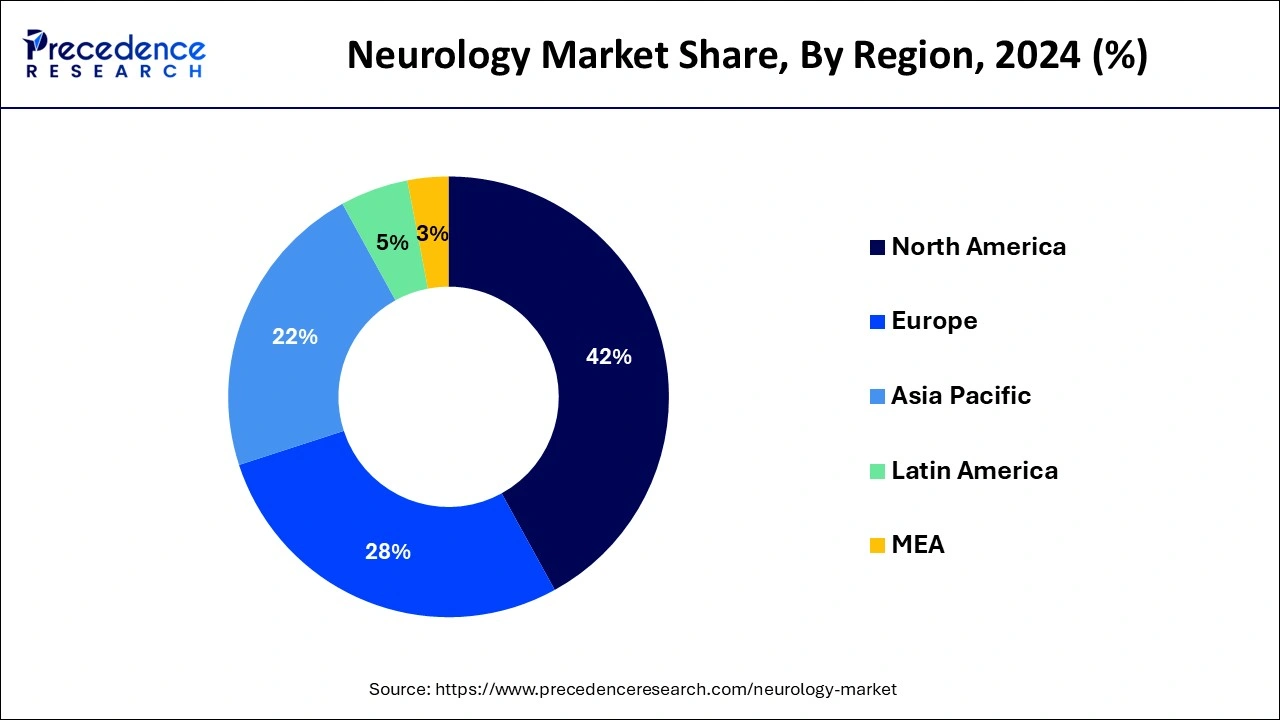List of Contents
Neurology Market Size and Forecast 2025 to 2034
The global neurology market size was estimated at USD 3.60 billion in 2024 and is predicted to increase from USD 3.88 billion in 2025 to approximately USD 7.57 billion by 2034, expanding at a CAGR of 7.72% from 2025 to 2034.

Neurology Market Key Takeaways
- The global neurology market was valued at USD 3.60 billion in 2024.
- It is projected to reach USD 7.57 billion by 2034.
- The neurology market is expected to grow at a CAGR of 7.72% from 2025 to 2034.
- North America contributed more than 42% of the market share in 2024.
- Asia Pacific is estimated to witness the fastest CAGR between 2025 and 2034.
- By type, the neurodegenerative diseases segment has held the largest market share of 59% in 2024.
- By type, the neurovascular diseases segment is anticipated to grow at a remarkable CAGR of 9.1% between 2025 and 2034.
- By procedure, the multiple sclerosis segment generated over 36% of revenue share in 2024.
- By procedure, the epilepsy segment is expected to expand at the fastest CAGR over the projected period.
- By end-user, the adult segment held the largest market share of 69% in 2024.
- By end-user, the pediatric segment is expected to expand at the fastest CAGR over the projected period.
- By application, the diagnostic centers segment generated over 48% of revenue share in 2024.
- By application, the hospital segment is expected to expand at the fastest CAGR over the projected period.
U.S. Neurology Market Size and Growth 2025 to 2034
The U.S. neurology market size was evaluated at USD 1.04 billion in 2024 and is projected to be worth around USD 2.31 billion by 2034, growing at a CAGR of 8.31% from 2025 to 2034.

North America has held the largest revenue share of 42% in 2024. In North America, the neurology market is propelled by robust research and development activities, cutting-edge technologies, and a well-established healthcare infrastructure. The region witnesses significant investments in neurology research, leading to advancements in diagnostics, therapeutics, and innovative treatment modalities. Patient-centric approaches and collaborations between industry players and research institutions contribute to the continual growth of neurology services in North America.
Asia Pacific is estimated to observe the fastest expansion. Asia Pacific experiences a growing demand for neurology services driven by an expanding population, increasing awareness of neurological disorders, and improving healthcare access. Rising healthcare expenditure and government initiatives to address neurological diseases further enhance the neurology market's prominence in the region. As healthcare systems in Asia-Pacific continue to evolve, there is a notable increase in neurology-focused research and the adoption of advanced technologies, shaping the landscape of neurological care in the region.
In Europe, the neurology market thrives on a robust healthcare system, sophisticated medical research, and a strong commitment to addressing neurological disorders. The region showcases a high level of expertise in neurology, with renowned research institutions and healthcare facilities driving advancements in diagnostics, treatments, and patient care. Collaborations between European countries contribute to a cohesive approach to neurology, ensuring access to cutting-edge therapies and fostering a supportive environment for both research and clinical applications.

Market Overview
The neurology market is a comprehensive domain covering the diagnosis, treatment, and management of disorders affecting the nervous system. Encompassing a wide range of conditions from neurodegenerative diseases like Alzheimer's and Parkinson's to neurovascular issues such as strokes, the market focuses on understanding and addressing disorders of the brain, spinal cord, and nerves.
It involves various medical professionals, diagnostics, and therapeutic interventions, contributing to the development of innovative treatments, diagnostic tools, and research to improve outcomes for patients affected by neurological conditions. The market plays a crucial role in addressing the complex and diverse challenges of neurological health.
Neurology Market Growth Factors
- Continuous breakthroughs and research in neuroscience drive ongoing innovation in treatments and diagnostic tools, elevating the standard of care.
- The collaboration among neurologists, neurosurgeons, and various specialists ensures a holistic and comprehensive approach to neurological disorders, fostering a more integrated and effective healthcare system.
- The Neurology Market caters to a broad spectrum of disorders, showcasing its adaptability to address complex conditions, including epilepsy, multiple sclerosis, and neuromuscular diseases.
- The relentless pursuit of scientific and medical advancements leads to the development of novel and effective treatments, providing hope for patients with previously challenging conditions.
- The increasing awareness of neurological health prompts early diagnosis and intervention, contributing to improved patient outcomes and overall community well-being.
- There are abundant opportunities for collaboration in neuroscience research, fostering partnerships between academic institutions, pharmaceutical companies, and healthcare providers.
- The evolving landscape of diagnostic solutions presents significant growth potential, with opportunities to pioneer innovative technologies for more accurate and timely diagnoses.
- The market offers opportunities for companies and institutions to spearhead the development of novel treatments, meeting the unmet needs of patients and contributing to medical breakthroughs.
- Collaboration with regulatory bodies and adherence to evolving regulations present opportunities to streamline approval processes, ensuring faster market access for new diagnostics and treatments.
- There is potential for initiatives focused on patient education, empowering individuals to better understand and manage their neurological health, leading to improved compliance and overall outcomes.
- Opportunities exist for companies to invest in preventive measures, including lifestyle interventions and early detection strategies, aiming to reduce the incidence of neurological disorders and enhance overall population health.
Market Scope
| Report Coverage | Details |
| Growth Rate from 2025 to 2034 | CAGR of 7.72% |
| Market Size in 2025 | USD 3.88 Billion |
| Market Size in 2024 | USD 3.60 Billion |
| Market Size by 2034 | USD 7.57 Billion |
| Largest Market | North America |
| Base Year | 2024 |
| Forecast Period | 2025 to 2034 |
| Segments Covered | Type, Procedure, End User, and Application |
| Regions Covered | North America, Europe, Asia-Pacific, Latin America, and Middle East & Africa |
Market Dynamics
Driver
Advances in neuroscience and research collaboration
Advances in neuroscience and collaborative research initiatives significantly contribute to the burgeoning demand in the neurology market. The evolving understanding of the intricate workings of the nervous system, propelled by breakthroughs in imaging technologies and molecular biology, fuels the development of novel diagnostics and therapeutic interventions. These advancements, ranging from deciphering genetic markers to exploring intricate neural networks, pave the way for innovative treatment modalities.
Research collaboration, both across academic institutions and industry players, fosters a collective approach to address the complex challenges posed by neurological disorders. By pooling resources, knowledge, and expertise, collaborative efforts accelerate the development of new drugs, therapies, and diagnostic tools. This synergy not only expedites the translation of scientific discoveries into practical applications but also enhances the overall effectiveness of neurological treatments, meeting the growing global demand for comprehensive and sophisticated solutions in neurology.
Restraint
Complexity of neurological disorders and high treatment costs
The intricate nature of neurological disorders poses a significant restraint on the neurology market. The complexity arises from the diverse range of disorders affecting the nervous system, each with unique characteristics and underlying mechanisms. Diagnosis and treatment often require specialized expertise, leading to challenges in developing universal solutions. This complexity contributes to the lengthy and resource-intensive research and development process, hindering the rapid introduction of new therapies.
High treatment costs represent another major restraint in the neurology market. The substantial investment in research and technology for the development of advanced diagnostic tools, therapeutic interventions, and pharmaceuticals contributes to the high cost of neurological treatments. This elevated cost creates a barrier to access for a considerable portion of the population, restricting the adoption of state-of-the-art treatments and exacerbating healthcare disparities. Initiatives aimed at addressing these challenges involve fostering research collaborations, securing increased funding, and advancing healthcare delivery models to enhance the accessibility and affordability of neurology services.
Opportunity
Regenerative medicine, neuroinformatic and data analytics
The integration of regenerative medicine into neurology offers innovative approaches for treating neurodegenerative diseases. Stem cell therapies and tissue engineering techniques hold promise for repairing damaged neural tissue, potentially slowing or reversing the progression of conditions like Alzheimer's and Parkinson's. This evolving field sparks research collaborations, clinical trials, and investments, indicating a growing interest in regenerative solutions for neurological disorders.
Neuroinformatic and data analytics play a pivotal role in advancing neurology by leveraging big data and artificial intelligence. The analysis of large datasets enables researchers to identify patterns, predict disease trajectories, and develop targeted interventions. With the increasing digitization of patient records, neuroinformatic facilitates precision medicine approaches, tailoring treatments to individual patient profiles. The combination of regenerative medicine and advanced data analytics propels the neurology market towards more personalized, effective, and data-driven approaches, fostering a new era of innovation and patient care.
Type Insights
According to the type, the neurodegenerative diseases segment has held a 59% revenue share in 2024. Neurodegenerative diseases involve progressive deterioration of the structure and function of the nervous system. Disorders like Alzheimer's and Parkinson's fall into this category. The market trends include a focus on disease-modifying therapies, precision medicine, and early detection through advanced imaging. Growing research on disease mechanisms and potential biomarkers enhances diagnostic accuracy and paves the way for targeted therapies, reflecting a shift towards personalized and effective interventions.
The neurovascular diseases segment is anticipated to expand at a significantly CAGR of 9.1% during the projected period. Neurovascular diseases affect the blood vessels in the brain, leading to conditions like strokes. Market trends in this segment revolve around endovascular treatments, thrombectomy devices, and neurointerventional procedures. Advances in neuroimaging techniques improve diagnostics, while innovations in minimally invasive interventions enhance patient outcomes. The emphasis on rapid and efficient treatments, especially in acute scenarios, drives the neurovascular segment towards more sophisticated and effective solutions.
Procedure Insights
Based on the procedure, the multiple sclerosis segment held the largest market share of 36% in 2024. Multiple sclerosis (MS) is a chronic autoimmune disease affecting the central nervous system. Trends in MS treatments involve the development of disease-modifying therapies (DMTs) that aim to manage symptoms, slow disease progression, and enhance quality of life.
On the other hand, the epilepsy segment is projected to grow at the fastest rate over the projected period. Epilepsy, a neurological disorder characterized by recurrent seizures, witnesses' trends in precision medicine, with a focus on identifying biomarkers for individualized treatment plans. Advancements in antiepileptic drugs, neuromodulation techniques, and non-invasive brain stimulation contribute to optimizing seizure control.
End-user Insights
In 2024, the adult segment had the highest market share of 69% on the basis of the end user. In adult neurology, the spotlight is on age-related neurodegenerative disorders like Alzheimer's and Parkinson's. Precision medicine and targeted therapies are trending, tailoring interventions based on individual patient profiles, including genetics and lifestyle, to improve outcomes.
The pediatric segment is anticipated to expand at the fastest rate over the projected period. Pediatric neurology addresses congenital and developmental disorders like epilepsy. Emerging trends include gene therapies and advanced diagnostic tools for early detection, showcasing the market's commitment to specialized care and research efforts in pediatric neurological conditions.
Application Insights
In 2024, the diagnostics centers segment held the highest market share of 48% on the basis of the end user. Neurological diagnostics centers focus on specialized testing and imaging procedures for precise neurology assessments. Advanced technologies like MRI, CT scans, and EEGs are employed, enhancing diagnostic accuracy. Trends include the adoption of high-resolution imaging modalities and automated analysis tools, ensuring more detailed and efficient neurodiagnostic evaluations.
The hospital segment is anticipated to expand at the fastest rate over the projected period. Hospitals are central hubs for comprehensive neurology care, offering a range of diagnostic, therapeutic, and surgical interventions. Neurology units within hospitals integrate multidisciplinary teams, fostering collaborative approaches to patient care. Trends involve the incorporation of telemedicine for remote consultations, ensuring broader access to specialized neurological expertise. Advanced neurosurgical techniques and minimally invasive procedures are becoming standard, contributing to improved patient outcomes.
Neurology Market Companies
- Siemens Healthineers AG
- GE Healthcare
- Medtronic plc
- Philips Healthcare
- Johnson & Johnson
- Stryker Corporation
- Abbott Laboratories
- Boston Scientific Corporation
- B. Braun Melsungen AG
- Carl Zeiss Meditec AG
- Toshiba Medical Systems Corporation
- Nihon Kohden Corporation
- Hitachi Medical Corporation
- Elekta AB
- Penumbra, Inc.
Recent Developments
- In 2023,the U.S. Food and Drug Administration (FDA) cleared Neurophet AQUA, an artificial intelligence (AI) software designed to enhance the evaluation of brain atrophy in MRI scans. This regulatory approval signifies a significant step in utilizing AI for more accurate and efficient assessments in neuroimaging, contributing to improved diagnostic capabilities.
- In 2022, CERENOVUS introduced EMBOGUARD, an innovative balloon guide catheter designed for endovascular procedures, particularly for patients dealing with acute ischemic stroke. The device reflects advancements in neurovascular interventions, emphasizing precision and efficacy in the treatment of cerebrovascular conditions.
Segments Covered in the Report
By Type
- Neurodegenerative Diseases
- Neurovascular Diseases
- Neuro-infectious Diseases
- Others
By Procedure
- Multiple Sclerosis
- Epilepsy
- Parkinson's Disease
- Alzheimer's Disease
- Stroke
- Others
By End User
- Adult
- Pediatric
By Application
- Hospitals
- Clinics
- Diagnostic Centers
- Research Institutes
- Others
By Geography
- North America
- Europe
- Asia-Pacific
- Latin America
- Middle East and Africa
For inquiries regarding discounts, bulk purchases, or customization requests, please contact us at sales@precedenceresearch.com
Frequently Asked Questions
Ask For Sample
No cookie-cutter, only authentic analysis – take the 1st step to become a Precedence Research client